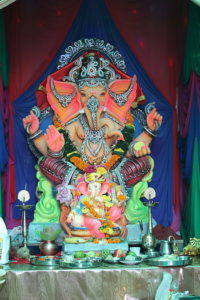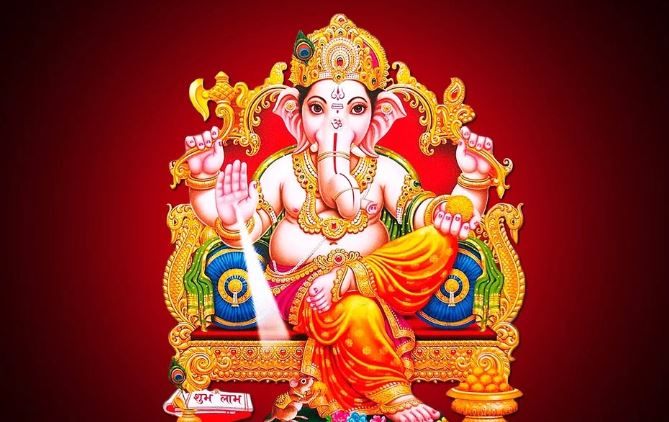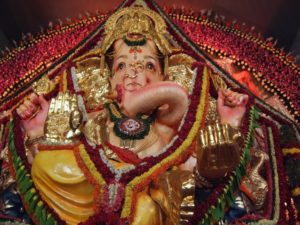Ganesha Chaturthi is the most universally celebrated Hindu festival throughout India. It is the celebration of the birthday of Lord Ganesha, the elephant-headed lord, the remover of all obstacles. His birthday falls at the beginning of August, on the fourth day of the new moon. (Chaturthi, being the fourth day of the new moon.)
The legend goes like this: Ganesha is the son of Lord Shiva and Goddess Parvathi. It is said that Lord Shiva used to go away for extended periods of time and immerse himself in Tapas, or meditation. During one such period, Parvathi, created the image of a human baby with mud and breathed life into it.
 Thus, Ganesha was born. For a long time, he did not get to see his father, Lord Shiva. He grew into a young lad. One day, Parvathi, asked the young boy to guard the entrance and not to let anyone enter, while she went about doing her daily obligations. The young son accordingly was guarding the entrance, when Lord Shiva suddenly appeared. He tried to go into his own abode but was barred entry by the young boy. Angered by this insolent lad, Lord Shiva, not knowing that it was his own son, chopped off his head. Parvathi rushed to the scene and was inconsolable in her grief. Looking at what he had done in haste, Lord Shiva wanted to make amends. He instructed his loyal servants to go around the entire globe, looking for a living being that was sleeping with its head toward the Northern direction. The servants went and searched all over. The only such living being that they could find was an elephant. Without a thought, they chopped off the elephant’s head and brought it back. Lord. Shiva was aghast, but there was nothing he could do at that point. He placed the elephant’s head near the neck of the boy. They joined together and the boy came back to life, with the head of an elephant! Till today, Hindu Vasthu, similar to Chinese Feng Shui, discourages people from sleeping with their heads in the northern direction. What is interesting to note, is that modern science also discourages it, taking clues from the magnetic fields of the north-south direction.
Thus, Ganesha was born. For a long time, he did not get to see his father, Lord Shiva. He grew into a young lad. One day, Parvathi, asked the young boy to guard the entrance and not to let anyone enter, while she went about doing her daily obligations. The young son accordingly was guarding the entrance, when Lord Shiva suddenly appeared. He tried to go into his own abode but was barred entry by the young boy. Angered by this insolent lad, Lord Shiva, not knowing that it was his own son, chopped off his head. Parvathi rushed to the scene and was inconsolable in her grief. Looking at what he had done in haste, Lord Shiva wanted to make amends. He instructed his loyal servants to go around the entire globe, looking for a living being that was sleeping with its head toward the Northern direction. The servants went and searched all over. The only such living being that they could find was an elephant. Without a thought, they chopped off the elephant’s head and brought it back. Lord. Shiva was aghast, but there was nothing he could do at that point. He placed the elephant’s head near the neck of the boy. They joined together and the boy came back to life, with the head of an elephant! Till today, Hindu Vasthu, similar to Chinese Feng Shui, discourages people from sleeping with their heads in the northern direction. What is interesting to note, is that modern science also discourages it, taking clues from the magnetic fields of the north-south direction.
Ganesha grew up.
One of his favorite foods is the Modak, a sweet pastry. On his birthday, he would ride from house to house, in pursuit of Modak. Needless to say, he attained a hefty size! His mode of transportation, however, was the mouse. One such night, on his birthday, when he was indulging himself thus, it is said, that he ate so many Modaks that his stomach split open! Not to be deterred he looked around and saw a snake slithering by. He picked it up, and tied it around his belly, like a belt. It probably held his tummy in place, but it scared the mouse so much, that it ran away in haste, causing Ganesha to fall down. This whole scene looked so hilarious, that the moon, the only witness to this entire incident, burst out laughing! This angered Ganesha, and he cursed the moon and banished it from the sky.
The world was in darkness.
All living beings went to Lord Ganesha and pleaded with him to reverse his curse. Lord Ganesha obliged, however with one condition. Whoever saw the face of the moon on his birthday would have a lot of problems. Later on, an antidote was given for this too.
As childish as this story may seem, it has meaningful aspects to appeal to folks from all walks of life. The perception of this story in different ways has no limitation to the grand celebrations. All over India, there are ten to eleven days of celebration. In keeping up with the original mythology, the idol of Ganesha is made in clay or mud. The size varies from six inches high to over six feet high! Makeshift Mantaps (place of worship) are erected all over the streets, in some cases blocking traffic! Musicians, dramatists and other artists are in great demand and perform in many places. It is a holiday for everyone. Modaks are prepared in every Hindu household and distributed to friends, family and anyone else who may be around! New clothes are bought. Gifts are exchanged.
On the last day, the huge Ganesha idols are carried in grand processions and finally submerged in water. The water can be a pond, lake or river. Those lucky enough to live on the coastline march it into the sea. Of late, environmental awareness has brought about many changes. More people are resorting to original mud idols. Lead-free and water-soluble paints are being used. In places where there are not many ponds or lakes, artificial ponds are created, for the sole purpose of submerging the idols. Whatever the model, the night ends with shouts of people, in various languages and dialects, chanting in unison, ” Come back soon next year, Lord Ganesha!”







